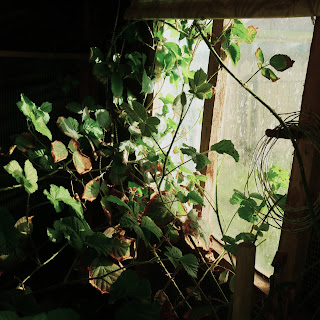Everywhere you look
you're reminded of the passage of time. Everything from the way the
pebbles that make up the shingle have worn smooth and the evolution
of the plants that grow among them (the sea cabbage especially) to
the sheds people have built, then abandoned. One, on a rise just
behind the shingle, barely hangs together, its rotten planks burst
apart by the wind exposing tea, salt and pepper still sat on a shelf,
a rusty bicycle. Another, its door come away, is full to what is left
of its rafters with brambles, the leaves pressing their eager faces
up against the window.
There are few buildings. Most of those
there are are strung out along the top of the rise behind the
shingle. A few yards inland, there is a small cluster of bungalows,
built in what once must've been a 'cheap and cheerful' style but
which now haunt us with visions of a world for which we can find no
modern equivalent. Mod cons – principally, the internet – have
had to be grafted on.
There is a road down to the sea that
ends in a car park. People come here to walk their dogs, entertain
their children or just sit and look. The tracks down to the shingle
are lined with pebbles people have painted and left there. This is a
pebble painter's paradise.
Sometimes, from here,
you can see the Isle of Man on the horizon. When you can, it's a
mirage: if the conditions are just right, the atmosphere refracts the
light, making the distant island (which lies way beyond the visible
horizon) appear surprisingly close. You can see its principal hills
spread out from left to right. I've never caught it in the act of
appearing or vanishing, though, although, the other evening,
conditions were such that you could only see the tops of its hills
poking above the milky obscurity. One can see how myths arose of
magic islands that appear and vanish and, scanning the horizon to see
if you can see Man from Silecroft, it's easy to start doubting the
science that tells you that what you're witnessing is no more than an
atmospheric effect.
Thursday, 25 May 2023
Silecroft
Saturday, 6 May 2023
Don't Say Nowt
Jumble Hole Clough's creator, Colin Robinson, describes it as 'music influenced by the landscape, industrial remains and experiences around Hebden Bridge in West Yorkshire. Forgotten things half-hidden beneath the undergrowth.' Robinson has now created forty-three albums under the Jumble Hole Clough name, the latest three being a trilogy based on written-down dreams ('the minor transient documents of everyday life', as he describes them). Over the previous forty, Robinson had moved gradually away from his self-imposed local brief. This trilogy, however, brings the world around Hebden Bridge back into focus: the calls of the curlews the crows and the sound of the church bells rising up from the valley (everyday experiences for anyone living around Hebden Bridge) mingle with more exotic, surreal dream-images. For example, someone – in one of the catchiest songs in the trilogy – has mysteriously filled the back of his car with riot-shields. I can't explain why I like that song as much as I do any more than I suspect Colin Robinson can explain why he dreamt it.
The first album of the
trilogy, with its ambiguous double-negative title, Don't Say Nowt
(and other dreams), contains conventional songs. Correction:
conventional JHC songs, which is not quite the same thing.
Conventional in JHC terms means short, sonically diverse and full of
tongue-in-cheek surrealism. These are the dreams you were dreaming
the moment you woke up: brief, vivid narratives with a logic of their
own, which seemed perfectly reasonable while you were dreaming them.
The second album,
You're Our Prisoner Now (and other dreams) is less conventional. All
the tracks were 'based initially on aleatoric methods: generative,
serial, Euclidean, tape loops and other such systems'. JHC produced its first album using generative music (...and I think the little
house knew something about it; don't you?) almost exactly a year ago.
One of the interesting things about that album – and this – is
that even when relinquishing control of the music to algorithms, it
still manages to sound like JHC.
The third album, The
Sunken Chapel (and other dreams) goes even further in this direction.
Listening to it for the first time, I immediately found myself
thinking of it as a series of sound-tracks to dreams, like an album
of the music for a film which only one person – in this case the
dreamer, Colin Robinson – has ever seen.
If you've never heard the music of JHC before but enjoy listening to these albums as much as I do, you have a treat in store: you've still got the forty other albums in the JHC back catalogue to listen to.
Broken Glass
“Kenneth,” said Mrs. Mackie, once the two boys had finished their drinks. “Why don’t you go and show Josh the beach?” This phrase stuck i...
-
There's still snow on the ground. For once, I'm not worried how I'm going to get around. I've nowhere to go. I said in an ea...
-
It'll soon be the end of 2020 and if I have a resolution for next year, it's to live life to the full. All the limits that have been...
-
You can read my short story, The Retreat, here , at International Times (IT). A soul-searching billionaire heads to the seaside in search of...





